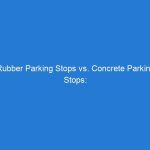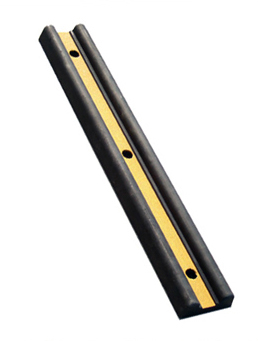Introduction: The Urgency of Effective Traffic Calming
In the realm of road safety, effective traffic calming measures are of utmost importance. The statistics of road accidents worldwide paint a grim picture, with the majority of these accidents caused by over-speeding. Among the various tools used to combat this issue, speed bumps stand out for their simplicity and effectiveness. In this article, we delve into the intricacies of one particular type – the recycled rubber speed bumps – and explore how they contribute to safer roads and lanes day and night.
High Visibility Speed Bumps: A Beacon of Safety
What makes a speed bump effective? It’s not just about the physical design that induces slower driving; it’s also about visibility. This holds true not only for speed bumps installed on public roads but also for driveway speed bumps used in private properties. A speed bump that isn’t clearly visible, especially at night, could pose a hazard rather than a safety feature.
Reflective Markings for Enhanced Visibility
Recycled rubber speed bumps are made from high-density rubber and painted in yellow and black, offering high contrast for enhanced visibility. A key feature of these speed bumps is the light reflective chevron on each middle section. This marking shows direction flow for approaching traffic and makes the bumps highly visible at night.
The thoughtfully placed reflective markings serve a dual purpose. First, they act as an early warning system for drivers, alerting them to the upcoming speed reduction device. Second, they indicate the direction of traffic flow, further enhancing road safety. With this design, the speed bumps keep your roads and lanes safe, regardless of the time of day or lighting conditions.
Ensuring Safety: The Practicality of Recycled Rubber Speed Bumps
High visibility isn’t the only thing these speed bumps have to offer. Designed with practicality and durability in mind, these speed bumps ensure all measures are taken to reduce risk on roads.
The Ideal Speed Reduction
The design of these speed bumps includes a height of 50mm. This height is enough to cause discomfort if driven over too quickly, encouraging drivers to slow down. The result? Traffic speed is reduced to less than 10 mph, ensuring the safety of people and property.
Longevity and Durability
All speed bumps, sleeping policemen, and speed ramps produced in a speed bumps factory are made from a 100% recycled solid rubber compound. This material guarantees longevity and durability, making these speed bumps a cost-effective long-term solution for traffic calming.
The 50mm and 75mm speed bumps, in particular, boast a weight capacity of 20,000kg. This high weight capacity means they can withstand heavy-duty vehicles, ensuring their performance isn’t compromised over time.
The Complete Speed Bump Kit: A Comprehensive Solution
The complete speed bump kit includes mid-sections, end-caps, and free fixings for tarmac and concrete, making installation easier and more efficient.
The mid-sections are the main body of the speed bump. They come with reflectors fitted as standard, reinforcing visibility at night. The end-caps, on the other hand, provide a smooth transition from the speed bump to the road surface, reducing the risk of vehicle damage.
Conclusion: Investing in Recycled Rubber Speed Bumps
In conclusion, recycled rubber speed bumps offer a practical, durable, and highly visible solution for traffic calming. With their reflective markings, they ensure safety 24/7. Their recycled rubber construction guarantees durability while promoting environmental sustainability.
By investing in recycled rubber speed bumps, we are not only making our roads safer but also contributing to a greener and more sustainable future. As we continue to navigate the complexities of urban development, solutions like these will play a critical role in building safer and more sustainable cities. After all, road safety is not a privilege; it is a right that every road user should enjoy.









